Assertion: Majority of the chemotherapeutic drugs have side effects like hair loss and anemia
Reason: Techniques of the molecular biology can be applied to detect genes in individuals with inherited susceptibility to certain cancers
If both assertion and reason are true and the reason is the correct explanation of the assertion.
If both assertion and reason are true but reason is not the correct explanation of the assertion.
If assertion is true but reason Is false.
If both assertion and reason are false.
The correct Answer is:B
Majority of the chemotherapeutic drugs have side effects like hair loss and anemia
Techniques of the molecular biology can be applied to detect genes in individuals with inherited susceptibility to certain cancers
Similar Questions
Read the passage given below and answer the question:
Industrially widely applied esterification reactions are commonly catalysed using mineral liquid acids, such as sulphuric acid and p-toluenesulphonic acid. The catalytic activity of homogeneous catalysts is high. They suffer, however, from several drawbacks, such as their corrosive nature, the existence of side reactions, and the fact that the catalyst cannot be easily separated from the reaction mixture. The use of solid acid catalysts offers an alternative and has received a lot of attention in the past years. Solid acid catalysts are not corrosive and, coated onto a support, they can be easily reused. Examples of solid acid catalysts used in esterification reactions include ion-exchange resins, zeolites and superacids like sulphated zirconia and niobium acid. Ion-exchange resins are the most common heterogeneous catalysts used and have proven to be effective in liquid phase esterification and etherification reactions. Because of their selective adsorption of reactants and swelling nature, these resins not only catalyse the esterification reaction but also affect the equilibrium conversion. Shortcomings include insufficient thermal resistance, which limits the reaction temperature to 120∘C, preventing widespread use in industry. Zeolites, like Y, X, BEA, ZSM-5 and MCM 41 offer an interesting alternative and have proven to be efficient catalysts for esterification reactions. Zeolites have found wide application in oil refining, petrochemistry and in the production of fine chemicals. Their success is based on the possibility to prepare zeolites with strong Brønsted acidity that can be controlled within a certain range, combined with a good resistance to high reaction temperatures.
In this study, the activity of various commercial available solid acid catalysts is assessed with respect to the esterification of acetic acid with butanol. The ion-exchange resins Amberlyst 15 and Smopex-101, the acid zeolites H-ZSM-5, H-MOR, H-BETA and H-USY, and the solid superacids sulphated zirconia and niobium acid are selected. Comparative esterification experiments have been carried out using the homogeneous catalysts sulphuric acid, p toluenesulphuric acid and a heteropolyacid (HPA). The weight-based activity of the heterogeneous catalysts tested is maximum for Smopex 101. The following table gives the activity of different catalysts in the esterification reaction between acetic acid and butanol at 75∘C.
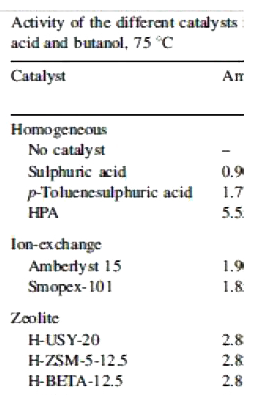
Here: kobs : observed reaction rate constant (m3mol−1s−1) kc catalysed reaction rate constant (m3mol−1g−1cats−1) Please note: k c = k obs/ amount (in g)
(source: PETERS, T., BENES, N., HOLMEN, A., & KEURENTJES, J. (2006). Comparison of commercial solid acid catalysts for the esterification of acetic acid with butanol. Applied Catalysis A: General, 297(2), 182-188. doi:10.1016/j.apcata.2005.09.00)
The weight-based activity of the heterogeneous catalysts tested decreases in the following order:View SolutionRead the passage given below and answer the question:
Industrially widely applied esterification reactions are commonly catalysed using mineral liquid acids, such as sulphuric acid and p-toluenesulphonic acid. The catalytic activity of homogeneous catalysts is high. They suffer, however, from several drawbacks, such as their corrosive nature, the existence of side reactions, and the fact that the catalyst cannot be easily separated from the reaction mixture. The use of solid acid catalysts offers an alternative and has received a lot of attention in the past years. Solid acid catalysts are not corrosive and, coated onto a support, they can be easily reused. Examples of solid acid catalysts used in esterification reactions include ion-exchange resins, zeolites and superacids like sulphated zirconia and niobium acid. Ion-exchange resins are the most common heterogeneous catalysts used and have proven to be effective in liquid phase esterification and etherification reactions. Because of their selective adsorption of reactants and swelling nature, these resins not only catalyse the esterification reaction but also affect the equilibrium conversion. Shortcomings include insufficient thermal resistance, which limits the reaction temperature to 120∘C, preventing widespread use in industry. Zeolites, like Y, X, BEA, ZSM-5 and MCM 41 offer an interesting alternative and have proven to be efficient catalysts for esterification reactions. Zeolites have found wide application in oil refining, petrochemistry and in the production of fine chemicals. Their success is based on the possibility to prepare zeolites with strong Brønsted acidity that can be controlled within a certain range, combined with a good resistance to high reaction temperatures.
In this study, the activity of various commercial available solid acid catalysts is assessed with respect to the esterification of acetic acid with butanol. The ion-exchange resins Amberlyst 15 and Smopex-101, the acid zeolites H-ZSM-5, H-MOR, H-BETA and H-USY, and the solid superacids sulphated zirconia and niobium acid are selected. Comparative esterification experiments have been carried out using the homogeneous catalysts sulphuric acid, p toluenesulphuric acid and a heteropolyacid (HPA). The weight-based activity of the heterogeneous catalysts tested is maximum for Smopex 101. The following table gives the activity of different catalysts in the esterification reaction between acetic acid and butanol at 75∘C.
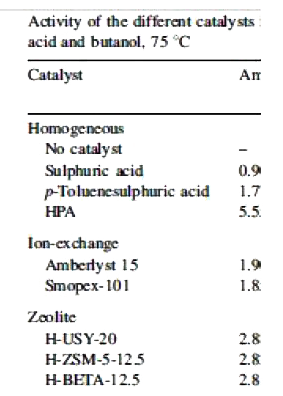
Here: kobs : observed reaction rate constant (m3mol−1s−1) kc catalysed reaction rate constant (m3mol−1g−1cats−1) Please note: k c = k obs/ amount (in g)
(source: PETERS, T., BENES, N., HOLMEN, A., & KEURENTJES, J. (2006). Comparison of commercial solid acid catalysts for the esterification of acetic acid with butanol. Applied Catalysis A: General, 297(2), 182-188. doi:10.1016/j.apcata.2005.09.00)
Catalysts used in oil refining industry are:View Solution
Knowledge Check
- Question 1 - Select One
Read the passage given below and answer the following questions:
The objects which are non-superimposable on their mirror image (like a pair of hands) are said to be chiral and this property is known as chirality. Chiral molecules are optically active, while the objects, which are, superimposable on their mirror images are called achiral. These molecules are optically inactive. The above test of molecular chirality can be applied to organic molecules by constructing models and its mirror images or by drawing three dimensional structures and attempting to superimpose them in our minds. There are other aids, however, that can assist us in recognising chiral molecules. One such aid is the presence of a single asymmetric carbon atom. In these questions a statement of assertion followed by a statement of reason is given . Choose the correct answer out of the following choices.
Assertion (A): A racemic mixture containing two enantiomers in equal proportions will have zero optical rotation.
Reason (R): This is because the rotation due to one isomer will be cancelled by the rotation due to the other isomer.AAssertion and Reason both are correct statements and Reason is correct explanation for Assertion.BAssertion and Reason both are correct statements but Reason is not correct explanation for AssertionCAssertion is correct statement but reason is wrong statement.DAssertion is wrong statement but Reason is correct statement. - Question 2 - Select One
Read the passage given below and answer the question:
Industrially widely applied esterification reactions are commonly catalysed using mineral liquid acids, such as sulphuric acid and p-toluenesulphonic acid. The catalytic activity of homogeneous catalysts is high. They suffer, however, from several drawbacks, such as their corrosive nature, the existence of side reactions, and the fact that the catalyst cannot be easily separated from the reaction mixture. The use of solid acid catalysts offers an alternative and has received a lot of attention in the past years. Solid acid catalysts are not corrosive and, coated onto a support, they can be easily reused. Examples of solid acid catalysts used in esterification reactions include ion-exchange resins, zeolites and superacids like sulphated zirconia and niobium acid. Ion-exchange resins are the most common heterogeneous catalysts used and have proven to be effective in liquid phase esterification and etherification reactions. Because of their selective adsorption of reactants and swelling nature, these resins not only catalyse the esterification reaction but also affect the equilibrium conversion. Shortcomings include insufficient thermal resistance, which limits the reaction temperature to 120∘C, preventing widespread use in industry. Zeolites, like Y, X, BEA, ZSM-5 and MCM 41 offer an interesting alternative and have proven to be efficient catalysts for esterification reactions. Zeolites have found wide application in oil refining, petrochemistry and in the production of fine chemicals. Their success is based on the possibility to prepare zeolites with strong Brønsted acidity that can be controlled within a certain range, combined with a good resistance to high reaction temperatures.
In this study, the activity of various commercial available solid acid catalysts is assessed with respect to the esterification of acetic acid with butanol. The ion-exchange resins Amberlyst 15 and Smopex-101, the acid zeolites H-ZSM-5, H-MOR, H-BETA and H-USY, and the solid superacids sulphated zirconia and niobium acid are selected. Comparative esterification experiments have been carried out using the homogeneous catalysts sulphuric acid, p toluenesulphuric acid and a heteropolyacid (HPA). The weight-based activity of the heterogeneous catalysts tested is maximum for Smopex 101. The following table gives the activity of different catalysts in the esterification reaction between acetic acid and butanol at 75∘C.
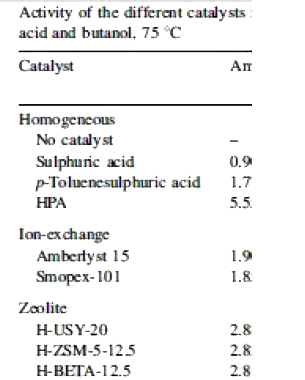
Here: kobs : observed reaction rate constant (m3mol−1s−1) kc catalysed reaction rate constant (m3mol−1g−1cats−1) Please note: k c = k obs/ amount (in g)
(source: PETERS, T., BENES, N., HOLMEN, A., & KEURENTJES, J. (2006). Comparison of commercial solid acid catalysts for the esterification of acetic acid with butanol. Applied Catalysis A: General, 297(2), 182-188. doi:10.1016/j.apcata.2005.09.00)
Which of the following are heterogeneous catalysts for esterifctaion reaction:Asulphuric acid and p-toluenesulphonic acidBsulphuric acid and niobium acidCp-toluenesulphonic acid and niobium acidDniobium acid and sulphated zirconia - Question 3 - Select One
There are three main factors that control the risks of becoming dependent on drugs. These factors are the type of drug, the personality of the individual, and the circumstances in which the drug is taken. Indeed, it could be said that the majority of the adult population have taken alcohol, yet few have become dependent on it. Also, many strong drugs that have been used for medical purposes have not caused the patient to become addicted.
However, it can be demonstrated that people who have taken drugs for fun are more likely to become dependent on the drug. The dependence is not always physiological but may remain psychological, although the effects are still essentially the same. Those at greatest risk appear to be personalities that are psychopathic, immature, or otherwise unstable.
Psychological dependence is very strong with heroin, morphine, cocaine, and amphetamines. Physiological dependence is great with heroin and morphine, but less with amphetamines, barbiturates, and alcohol.AOne cannot become addicted to certain drugs if one has a strong personalityBTaking drugs for ''kicks'' increases the possibility of becoming dependent on drugsCPsychological dependence is the greatest with heroinDAlcohol is a safe drug since very few people become dependent on it
Read the passage given below and answer the question:
Industrially widely applied esterification reactions are commonly catalysed using mineral liquid acids, such as sulphuric acid and p-toluenesulphonic acid. The catalytic activity of homogeneous catalysts is high. They suffer, however, from several drawbacks, such as their corrosive nature, the existence of side reactions, and the fact that the catalyst cannot be easily separated from the reaction mixture. The use of solid acid catalysts offers an alternative and has received a lot of attention in the past years. Solid acid catalysts are not corrosive and, coated onto a support, they can be easily reused. Examples of solid acid catalysts used in esterification reactions include ion-exchange resins, zeolites and superacids like sulphated zirconia and niobium acid. Ion-exchange resins are the most common heterogeneous catalysts used and have proven to be effective in liquid phase esterification and etherification reactions. Because of their selective adsorption of reactants and swelling nature, these resins not only catalyse the esterification reaction but also affect the equilibrium conversion. Shortcomings include insufficient thermal resistance, which limits the reaction temperature to 120∘C, preventing widespread use in industry. Zeolites, like Y, X, BEA, ZSM-5 and MCM 41 offer an interesting alternative and have proven to be efficient catalysts for esterification reactions. Zeolites have found wide application in oil refining, petrochemistry and in the production of fine chemicals. Their success is based on the possibility to prepare zeolites with strong Brønsted acidity that can be controlled within a certain range, combined with a good resistance to high reaction temperatures.
In this study, the activity of various commercial available solid acid catalysts is assessed with respect to the esterification of acetic acid with butanol. The ion-exchange resins Amberlyst 15 and Smopex-101, the acid zeolites H-ZSM-5, H-MOR, H-BETA and H-USY, and the solid superacids sulphated zirconia and niobium acid are selected. Comparative esterification experiments have been carried out using the homogeneous catalysts sulphuric acid, p toluenesulphuric acid and a heteropolyacid (HPA). The weight-based activity of the heterogeneous catalysts tested is maximum for Smopex 101. The following table gives the activity of different catalysts in the esterification reaction between acetic acid and butanol at 75∘C.
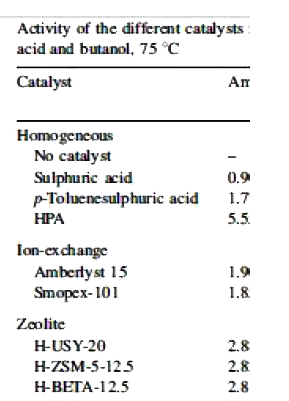
Here: kobs : observed reaction rate constant (m3mol−1s−1) kc catalysed reaction rate constant (m3mol−1g−1cats−1) Please note: k c = k obs/ amount (in g)
(source: PETERS, T., BENES, N., HOLMEN, A., & KEURENTJES, J. (2006). Comparison of commercial solid acid catalysts for the esterification of acetic acid with butanol. Applied Catalysis A: General, 297(2), 182-188. doi:10.1016/j.apcata.2005.09.00)
The catalytic activity of homogeneous catalysts is high. The weight based activity of HPA is less than which of the following heterogenous catalysts?View SolutionRead the passage given below and answer the question:
Industrially widely applied esterification reactions are commonly catalysed using mineral liquid acids, such as sulphuric acid and p-toluenesulphonic acid. The catalytic activity of homogeneous catalysts is high. They suffer, however, from several drawbacks, such as their corrosive nature, the existence of side reactions, and the fact that the catalyst cannot be easily separated from the reaction mixture. The use of solid acid catalysts offers an alternative and has received a lot of attention in the past years. Solid acid catalysts are not corrosive and, coated onto a support, they can be easily reused. Examples of solid acid catalysts used in esterification reactions include ion-exchange resins, zeolites and superacids like sulphated zirconia and niobium acid. Ion-exchange resins are the most common heterogeneous catalysts used and have proven to be effective in liquid phase esterification and etherification reactions. Because of their selective adsorption of reactants and swelling nature, these resins not only catalyse the esterification reaction but also affect the equilibrium conversion. Shortcomings include insufficient thermal resistance, which limits the reaction temperature to 120∘C, preventing widespread use in industry. Zeolites, like Y, X, BEA, ZSM-5 and MCM 41 offer an interesting alternative and have proven to be efficient catalysts for esterification reactions. Zeolites have found wide application in oil refining, petrochemistry and in the production of fine chemicals. Their success is based on the possibility to prepare zeolites with strong Brønsted acidity that can be controlled within a certain range, combined with a good resistance to high reaction temperatures.
In this study, the activity of various commercial available solid acid catalysts is assessed with respect to the esterification of acetic acid with butanol. The ion-exchange resins Amberlyst 15 and Smopex-101, the acid zeolites H-ZSM-5, H-MOR, H-BETA and H-USY, and the solid superacids sulphated zirconia and niobium acid are selected. Comparative esterification experiments have been carried out using the homogeneous catalysts sulphuric acid, p toluenesulphuric acid and a heteropolyacid (HPA). The weight-based activity of the heterogeneous catalysts tested is maximum for Smopex 101. The following table gives the activity of different catalysts in the esterification reaction between acetic acid and butanol at 75∘C.

Here: kobs : observed reaction rate constant (m3mol−1s−1) kc catalysed reaction rate constant (m3mol−1g−1cats−1) Please note: k c = k obs/ amount (in g)
(source: PETERS, T., BENES, N., HOLMEN, A., & KEURENTJES, J. (2006). Comparison of commercial solid acid catalysts for the esterification of acetic acid with butanol. Applied Catalysis A: General, 297(2), 182-188. doi:10.1016/j.apcata.2005.09.00)
Unit for observed rate constant for esterification reaction is m³ mol^-1s^-1, so the reaction is:View SolutionAssertion:A pair of closely spaced electron and proton behaves like an electrically neutral particle system and do not apply electric force on isolated proton or electron.
Reason: Two types of charges exist in nature, which are opposite to'each other in polarity. These two types of charges have a tendency to cancel the electrical effect of each other. Benjamin Franklin suggested the use of positive and negative signs to represent these two types of charges. We can calculate the net charge of any system by evaluating the algebraic sum of individual charges.View SolutionSickle cell anemia is a genetic disorder where the body produces an abnormal hemoglobin called hemoglobin S. Red blood cells are normally flexible and round, but when the hemoglobin is defective, blood cells take on a “sickle” or crescent shape. Sickle cell anemia is caused by mutations in a gene called HBB. It is an inherited blood disorder that occurs if both the maternal and paternal copies of the HBB gene are defective. In other words, if an individual receives just one copy of the defective HBB gene, either from mother or father, then the individual has no sickle cell anemia but has what is called “sickle cell trait”. People with sickle cell trait usually do not have any symptoms or problems but they can pass the mutated gene onto their children. There are three inheritance scenarios that can lead to a child having sickle cell anemia:
- Both parents have sickle cell trait
- One parent has sickle cell anemia and the other has sickle cell trait
- Both parents have sickle cell anemia
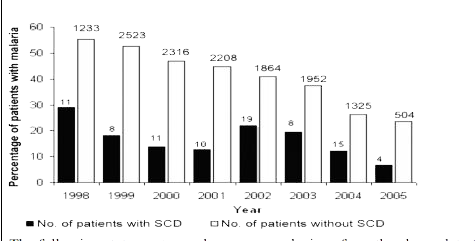
The following statements are drawn as conclusions from the above data (Kenya).
I. Patients with SCD (Sickle Cell Disease) are less likely to be infected with malaria.
II. Patients with SCD (Sickle Cell Disease) are more likely to be infected with malaria.
III. Over the years the percentage of people infected with malaria has been decreasing.
IV. Year 2000 saw the largest percentage difference between malaria patients with and without SCD.
Choose from below the correct alternative.View SolutionFollowing questions are based on passage given below:
The driving force of evolution, according to the emerging new theory, is not to be found in the chance events of random mutations but in life's inherent tendency to create novelty, in the spontaneous emergence of increasing complexity and order. Once this fundamental new insight has been understood, we can then ask: What are the avenues in which evolution's creativity expresses itself?The answer to this question comes not only from molecular biology but also, and even more importantly, from microbiology, from the study of the planetary web of the myriads of microorganisms that were the only forms of life during the first two billion years of evolution. During those two billion years, bacteria continually transformed the Earth's surface and atmosphere and, in so doing, invented all of life's essential biotechnologies, including fermentation, photosynthesis, nitrogen fixation, respiration, and rotary devices for rapid motion.During the past three decades, extensive research in microbiology has revealed three major avenues of evolution.The first, but least important, is the random mutation of genes, the centrepiece of neo-Darwinian theory. Gene mutation is caused by a chance error in the self-replication of DNA, when the two chains of the DNA's double helix separate and each of them serves as a template for the construction of a new complementary chain.If all human beings started behaving like bacteria, It has been estimated that those chance errors occur at a rate of about one per several hundred million cells in each generation. This frequency does not seem to be sufficient to explain the evolution of the great diversity of life forms, given the well-known fact that most mutations are harmful, and only very few result in useful variations.In the case of bacteria the situation is different, because bacteria divides so rapidly. Fast bacteria can divide about every twenty minutes, so that in principle several billion individual bacteria can be generated from a single cell in less than a day. Because of this enormous rate of reproduction, a single successful bacterial mutant can spread rapidly through its environment, and mutation is indeed an important evolutionary avenue for bacteria.However, bacteria have developed a second avenue of evolutionary creativity that is vastly more effective than random mutation. They freely pass hereditary traits from one to another in a global exchange network of incredible power and efficiency. Here is how Lynn Margulis and Dorion Sagan describe it:Over the past fifty years or so, scientists have observed that [bacteria) routinely and rapidly transfer different bits of genetic material to other individuals. Each bacterium at any given time has the use of accessory genes, visiting from sometimes very different strains, which perform functions that its own DNA may not cover. Some of the genetic bits are recombined with the cell's native genes, others are passed on again. As a result of this ability, all the world's bacteria essentially have access to a single gene pool and hence to the adaptive mechanisms of the entire bacterial kingdom.This global trading of genes, technically known as DNA recombination, must rank as one of the most astonishing discoveries of modern biology. 'If the genetic properties of the microcosm were applied to larger creatures, we would have a science-fiction world,' write Margulis and Sagan, 'in which green plants could share genes for photosynthesis with nearby mushrooms, or where people could exude perfumes, or grow ivory by picking up genes from a rose or a walrus.'The speed with which drug resistance spreads among bacterial communities is dramatic proof that the efficiency of their communications network is vastly superior to that of adaptation through mutations. Bacteria are able to adapt to environmental changes in a few years where larger organisms would need thousands of years of evolutionary adaptation. Thus microbiology teaches us the sobering lesson that technologies like genetic engineering and a global communications network, which we consider to be advanced achievements of our modern civilization, have been used by the planetary web of bacteria for billions of years to regulate life on Earth.The constant trading of genes among bacteria results in an amazing variety of genetic structures besides their main strand of DNA. These include the formation of viruses, which are not full autopoietic systems but consist merely of a stretch of DNA or RNA in a protein coating. In fact, Canadian bacteriologist.Sorin Sonea has argued that bacteria, strictly speaking, should not be classified into species, since all of their strains can potentially share hereditary traits and, typically, change up to fifteen percent of their genetic material on a daily basis. 'A bacterium is not a unicellular organism,' writes Sonea, 'it is an incomplete cell belonging to different chimeras according to circumstances. In other words, all bacteria are part of a single microcosmic web of life'.
Which three processes are responsible for evolution:View Solution

